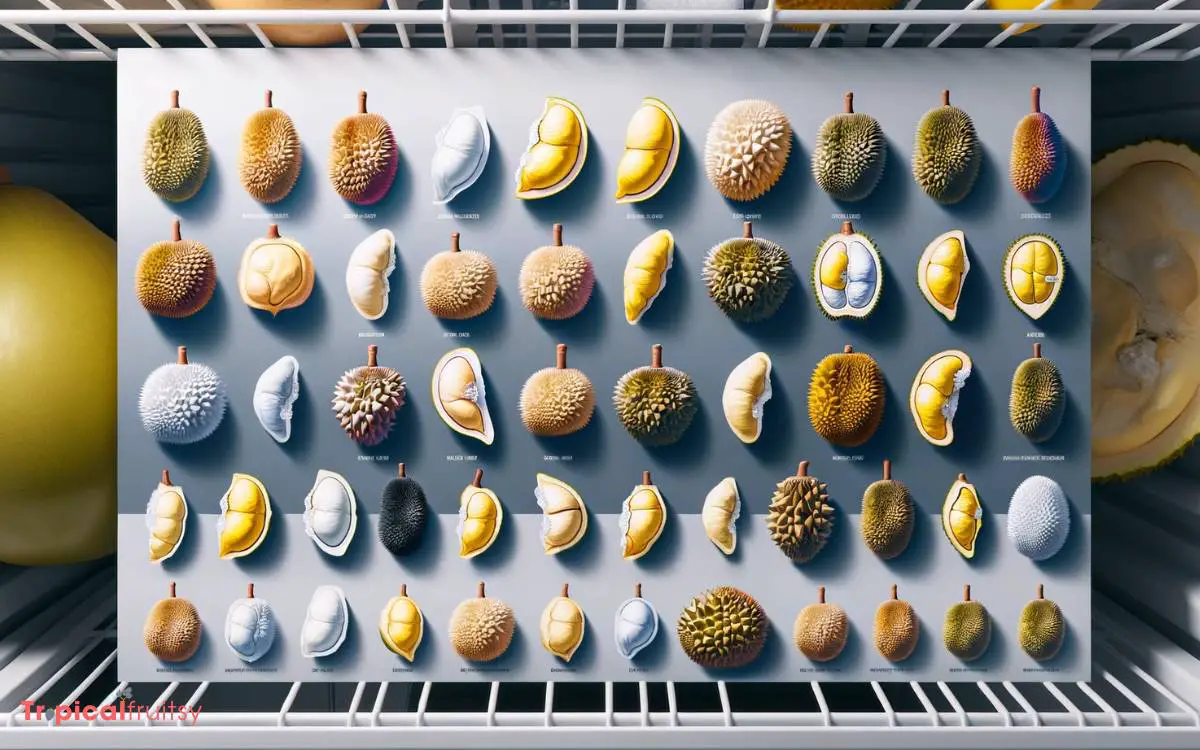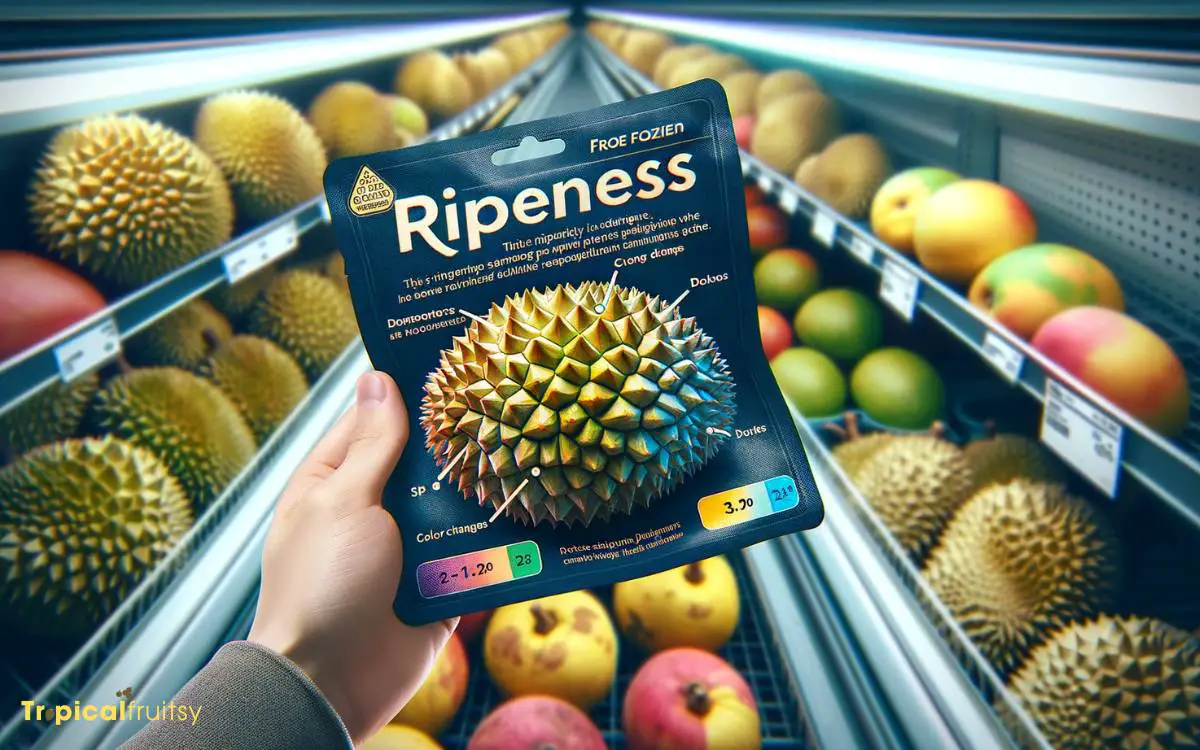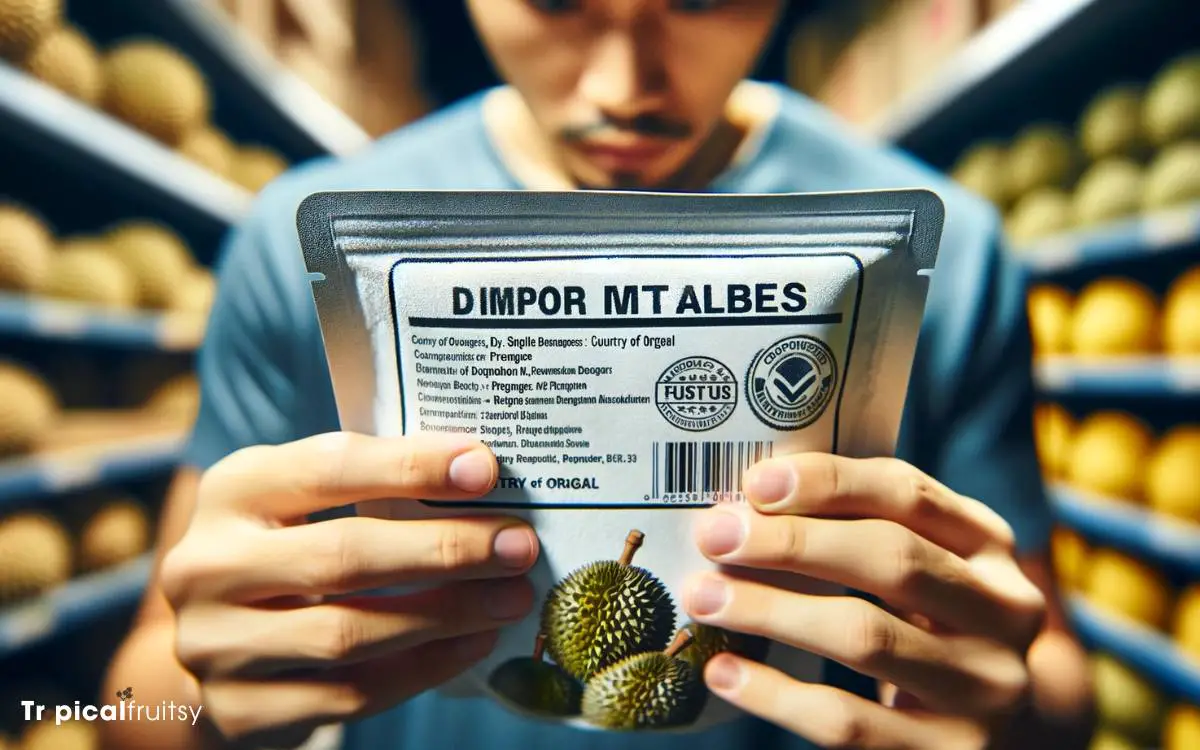How to Pick Frozen Durian? 8 Easy Steps!
To choose a quality frozen durian, it’s important to consider the variety, examine packaging for freezer burn, and understand the thawing process to ensure optimal flavor and texture.
Checking the smell, origin, and price also aids in making an informed decision.
Here are some quick steps:
A well-picked frozen durian offers a taste of tropical indulgence, capturing the essence of the fresh fruit’s complex flavors.

Key Takeaway
Understand Durian Varieties

Selecting the right frozen durian begins with understanding the various cultivars, each with distinct flavors and textures.
The most coveted variety, Musang King, is renowned for its rich, creamy consistency and sweet, complex flavor with a hint of bitterness. D24, another popular choice, offers a slightly less intense flavor but a similarly buttery texture.
For those seeking a milder taste, the Red Prawn variety provides a more subtle sweetness with a soft, custard-like flesh. It is imperative to identify the source of the durian, as the region of cultivation can significantly influence the fruit’s characteristics.
A knowledgeable selection of frozen durian hinges upon recognizing these nuances, ensuring a satisfactory gastronomic experience for aficionados and novices alike.
Step 1: Assessing Freezer Burn

When selecting frozen durian, it is crucial to evaluate the presence of freezer burn, which can significantly impact the fruit’s texture and flavor.
Ice crystals on the surface or within the packaging are telltale signs, indicating that the fruit has been stored for an extended period or exposed to varying temperatures.
Additionally, any discoloration or a grayish-brown tinge on the durian’s flesh suggests oxidation and dehydration, further symptoms of freezer burn that consumers should be vigilant about.
Identify Ice Crystals
One should carefully inspect the frozen durian for the presence of ice crystals, as these are indicative of freezer burn and can compromise the fruit’s quality.
Freezer burn occurs when air reaches the fruit’s surface and causes dehydration and oxidation. This not only alters the durian’s texture, rendering it dry and fibrous, but can also affect its rich and creamy taste, diminishing the overall sensory experience.
To assist consumers in recognizing freezer burn, the following table summarizes key visual indicators:
| Indicator | Description | Impact on Durian |
|---|---|---|
| Large Ice Crystals | Visible, chunky ice formations | Likely freezer burn |
| Frost on Packaging | White coating inside the package | Possible dryness |
| Discolored Durian Flesh | Graying or brownish hues | Flavor alteration |
Careful examination against these criteria will help in selecting a frozen durian that retains its desired qualities.
Check Surface Discoloration
Examine the durian’s outer layer carefully for any signs of discoloration, as this can point to freezer burn and impact the fruit’s quality.
Freezer burn occurs when air reaches the fruit’s surface, causing dehydration and oxidation. This not only alters the appearance but can also affect the taste and texture of the durian.
Consider the following when assessing for freezer burn:
- Uneven Color Patches: Look for areas where the color is inconsistent, indicating drying and oxidation.
- Grayish-Brown Spots: These spots suggest prolonged exposure to air and freezing temperatures.
- Overall Dullness: A lackluster surface, as opposed to a vibrant one, can be a telltale sign of quality degradation due to freezer burn.
Selecting a durian with a consistent, natural color ensures a more enjoyable eating experience.
Step 2: Check the Packaging Integrity

Ensure that the packaging of the frozen durian is intact and free from any signs of damage or tampering before making a purchase. The integrity of the packaging is crucial as it protects the durian’s quality and prevents contamination.
Inspect the package for any rips, tears, or punctures that may have compromised the fruit’s sanitary barrier.
A hermetically sealed package ensures that the durian has been kept at an optimal temperature and reduces the risk of freezer burn, which can adversely affect flavor and texture.
Furthermore, a secure package indicates that the product has not been previously opened or exposed to external elements, thereby maintaining its freshness.
Always opt for packaging that looks robust and undisturbed, as this is indicative of careful handling and adherence to food safety standards.
Step 3: Inspect for Ripeness Indicators

When selecting frozen durian, it’s crucial to discern the ripeness indicators that are observable even through the chill.
The color and texture of the durian’s flesh can suggest its maturity level and potential sweetness, with a rich, golden hue and a creamy consistency being ideal.
Additionally, a subtle yet distinct aroma, often perceivable when the fruit is partially thawed, is a hallmark of a ripe durian ready for consumption.
Color and Texture
Upon selecting a frozen durian, it is crucial to assess the color and texture, as these are key indicators of the fruit’s ripeness and quality.
The ideal frozen durian should exhibit certain characteristics that suggest it was frozen at the peak of its ripeness, thus ensuring the best flavor profile.
- Uniform Coloration: Look for a consistent, golden-yellow hue, indicating even ripeness prior to freezing.
- Firmness with Slight Give: The durian should feel firm but yield slightly under pressure, signifying a creamy, yet not overly mushy consistency.
- Intact Thorns: Thorns on the husk should be robust and unbroken, reflecting careful handling and potential quality preservation.
Understanding these visual and tactile cues will better prepare you for the next critical step: assessing the thawing process and aroma.
Thawing and Smell
Proper thawing of a frozen durian is essential to accurately assess its aroma, which is a critical indicator of the fruit’s ripeness and potential quality.
To ensure a thorough evaluation, allow the durian to thaw at room temperature, avoiding any heat sources that might artificially intensify the smell.
A ripe durian will emit a distinctively strong and somewhat sweet aroma. If the smell is faint or absent, the fruit may not be fully ripe or may have lost quality during freezing.
| Indicator | Significance |
|---|---|
| Intense Aroma | Suggests optimal ripeness |
| Sweetness in Smell | Indicates high sugar content |
| Faint Smell | May signify under-ripeness |
Assessing the aroma after thawing not only signifies ripeness but also helps to determine if the durian has been properly handled and stored prior to freezing.
Step 4: Consider the Thawing Process

In regard to the thawing process, selecting a frozen durian requires careful attention to ensure the fruit retains its optimal texture and flavor once defrosted.
When choosing a frozen durian, it is essential to consider the defrosting method that will be used, as it can significantly affect the quality of the fruit.
The following key points should be kept in mind:
- Uniformity of Thawing: Ensure that the durian thaws evenly to prevent any texture inconsistencies.
- Temperature Control: Slow thawing in the refrigerator is preferable to maintain the integrity of the fruit.
- Moisture Retention: Proper packaging during thawing minimizes moisture loss and preserves the durian’s creamy consistency.
For connoisseurs and casual consumers alike, respecting these factors ensures a delightful experience with this unique fruit after it has been frozen and subsequently thawed.
Step 5: Smell Test Before Purchase

A discerning olfactory examination is a crucial step when selecting a frozen durian, as the fruit’s aroma can be indicative of its quality and ripeness.
While frozen durian will not emit as strong a scent as its fresh counterpart, a subtle yet discernible smell should be detectable through the packaging when thawed slightly.
This smell test can help determine the potential freshness and flavor profile of the durian inside.
| Odor Quality | Indication | Action |
|---|---|---|
| No Smell | Underripe or Over-Processed | Consider another option |
| Mildly Sweet | Good Ripeness | Likely a good choice |
| Strong, Unpleasant | Possible Spoilage | Avoid purchasing |
| Alcohol or Fermented | Overripe or Spoiled | Do not buy |
| Consistent with Durian | Properly Frozen | Optimal selection |
After ensuring the frozen durian passes the smell test, it is important to review import labels to understand the fruit’s origin and compliance with safety standards.
Step 6: Review Import Labels

Examining the import labels on frozen durian provides essential information about its country of origin and adherence to food safety regulations.
These labels are a testament to the quality and traceability of the fruit, ensuring consumers are making well-informed decisions.
When reviewing import labels, consider the following:
- Country of Origin: Verify the source country to assess the durian’s authenticity and flavor profile.
- Export Standards: Look for compliance with international export standards, indicating quality and safety.
- Batch Information: Check for batch numbers and packing dates for freshness and recall information.
An informed understanding of these label details not only guarantees a safer culinary experience but also supports ethical trade practices.
Step 7: Evaluate Price Points

Moving beyond label scrutiny, evaluating the price points of frozen durian is a critical step in discerning the fruit’s quality and origin.
The market offers a wide range of frozen durian products, each with its own price tag that often reflects the cultivar, source, and processing standards.
To make an informed purchase, consider the typical price ranges and what they signify about the durian’s characteristics.
Here is a comparative table of different frozen durian price points:
| Quality Tier | Origin | Approximate Price Range (per kg) |
|---|---|---|
| Premium | Thailand/Malaysia | $15 – $30 |
| Mid-tier | Vietnam/Philippines | $10 – $15 |
| Budget | Local or Unspecified | $5 – $10 |
The price often corresponds to the durian’s breed, ripeness at the time of freezing, and the care taken during the preservation process.
Step 8: Storing Your Frozen Durian

Proper storage of the frozen durian is essential to maintain its quality and flavor after purchase. Once you’ve selected your frozen fruit, adhering to optimal storage conditions is crucial to preserve its taste and nutritional value.
The durian’s infamous aroma is contained when frozen, but improper storage can lead to quick degradation once it’s thawed.
To ensure your durian remains in peak condition, consider the following guidelines:
- Keep it Frozen: Store your durian at a consistent temperature of 0°F (-18°C) or below.
- Airtight Packaging: Ensure the fruit is sealed in airtight packaging to prevent freezer burn and odor transfer to and from other foods.
- Thawing Process: When ready to consume, thaw the durian in the refrigerator, not at room temperature, to maintain texture and quality.
Conclusion
The selection of frozen durian demands a discerning approach. One must navigate through the complexities of variety, signs of optimal ripeness, and the absence of freezer burn, all while considering the integrity of packaging and importation standards.
The olfactory inspection remains a crucial, albeit challenging, step in retail environments. A meticulously chosen durian promises a rewarding culinary experience, provided it is stored correctly post-purchase.
The connoisseur’s patience is thus a virtue, rewarded by the king of fruits in its frozen form.






